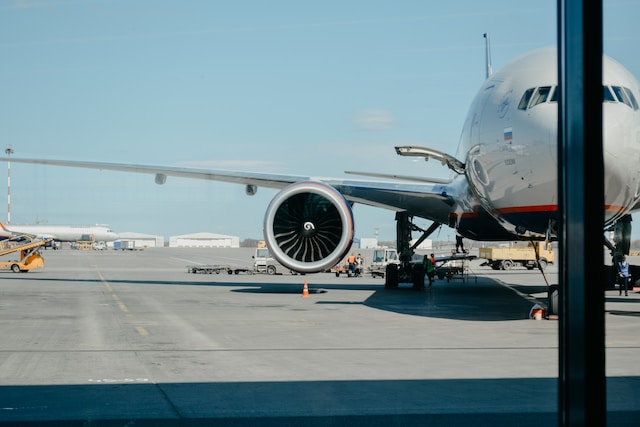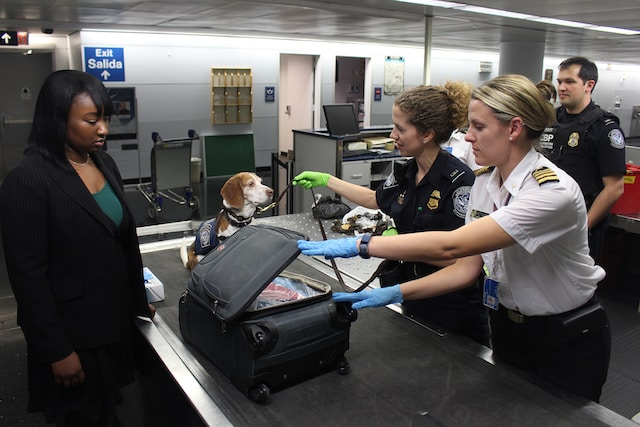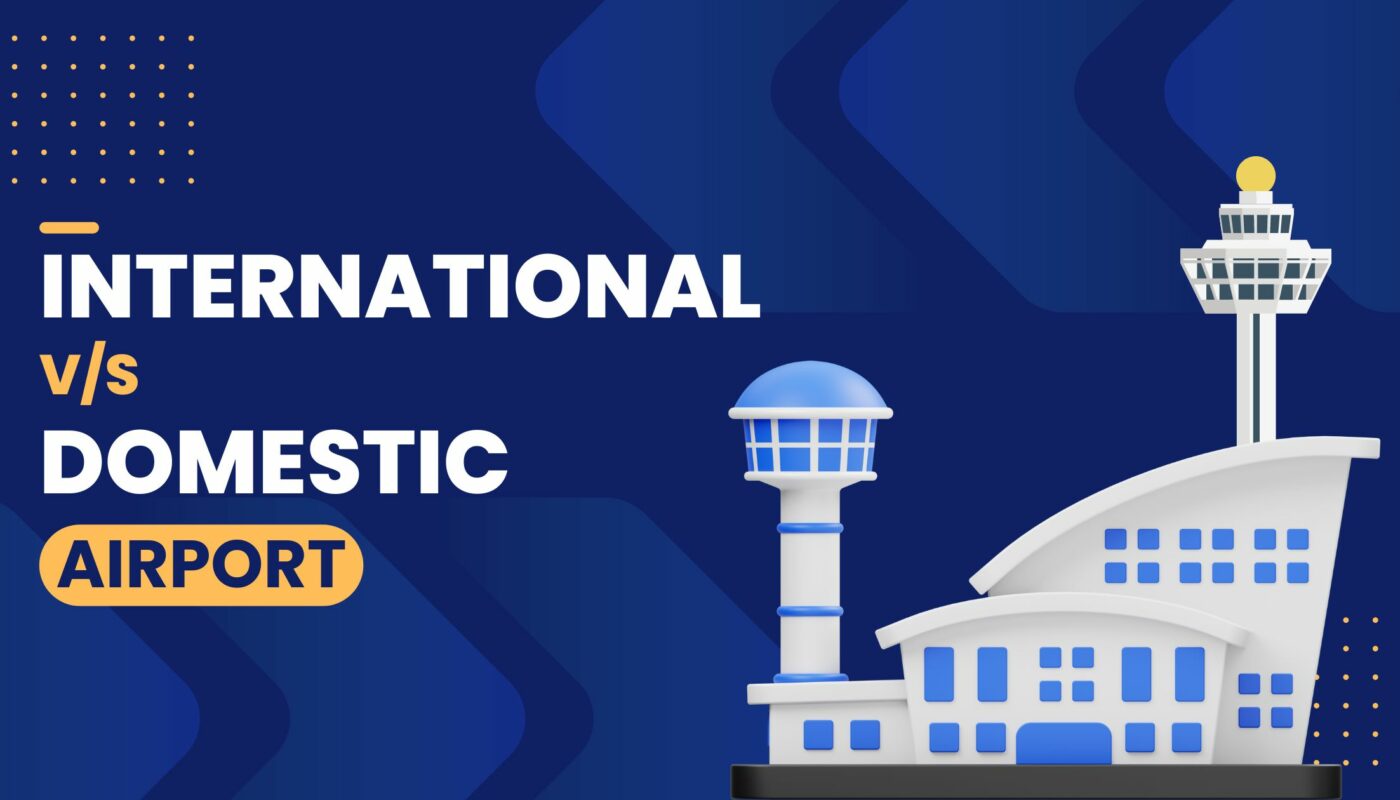Obviously, all of us know about international and domestic airports. But what is the difference between the two? While they may seem similar at first glance, there are actually several key distinctions that make each type unique.
Understanding the differences between international and domestic airports is essential for any traveler. In this article, we will explore the key factors that set international and domestic airports apart, helping you navigate the world of air travel with confidence.
International And Domestic Airport – What Is The Difference Between The Two?
The main difference between international and domestic airports is the type of flights handled. International airports cater to flights that travel between different countries, while domestic airports handle flights that operate within the same country. International airports have customs and immigration facilities and domestic airports do not require these facilities.
This is because passengers do not cross international borders.
Additionally, international airports often have a wider range of amenities and services to accommodate international travelers.
Now, let us have a look at the key differences between the two types of airports in detail:
International Airports
International airports are designed to facilitate the transfer of passengers and cargo between countries. As such, they are set up for border control and customs inspections.
These inspections generally involve going through immigration and customs in order to determine if travelers meet the requirements for entering a country.
Additionally, international airports also have more stringent security measures than domestic airports due to the larger number of passengers and the fact that many of them are coming from different countries.
Domestic Airports
Conversely, domestic airports primarily serve travelers who are staying within the same country’s borders. As such, they don’t have to go through immigration or customs in order to enter or leave the country.
Accordingly, these airports tend to have less stringent security measures than international airports.
However, this doesn’t mean that domestic airports are any less secure.
In fact, they often have more sophisticated surveillance and screening processes than international airports.
What Is An International Airport?

An international airport is an airport that has customs and immigration facilities, allowing it to handle international flights and passengers. These airports typically have a larger infrastructure and more extensive services than domestic airports, as they cater to a larger volume of travelers from different countries.
International airports often have multiple terminals, duty-free shops, restaurants, and hotels to accommodate the needs of international travelers.
They also have immigration and customs checkpoints where passengers go through passport control and have their luggage inspected.
These airports play a crucial role in facilitating international travel and connecting countries around the world.
What Are Some Of The Largest International Airports?
Some of the largest international airports in the world include Hartsfield-Jackson Atlanta International Airport in Atlanta, Georgia, which is the busiest airport in terms of passenger traffic. Other major international airports include Beijing Capital International Airport in Beijing, China, which is the second busiest airport globally.
Dubai International Airport in Dubai, United Arab Emirates, which is the third busiest airport in terms of international passenger traffic.
Other notable international airports include Tokyo Haneda Airport in Tokyo, Japan, and London Heathrow Airport in London, United Kingdom.
These airports handle millions of passengers and have extensive flight connections to various destinations around the world.
Here, is a table with some famous international airports and their otal area:
| International Airport | Location | Total Area (square kilometers) |
| Dubai International Airport | Dubai, UAE | 7.2 |
| Beijing Capital International Airport | Beijing, China | 23.8 |
| Hartsfield-Jackson Atlanta International Airport | Atlanta, USA | 13.6 |
| Charles de Gaulle Airport (Aéroport de Paris-Charles-de-Gaulle) | Paris, France | 32.4 |
| Suvarnabhumi Airport | Bangkok, Thailand | 32.4 |
| Tokyo Haneda Airport | Tokyo, Japan | 5.3 |
| London Heathrow Airport | London, UK | 12.27 |
| Los Angeles International Airport (LAX) | Los Angeles, USA | 12.87 |
| Sydney Kingsford Smith Airport | Sydney, Australia | 2.97 |
| Frankfurt am Main Airport | Frankfurt, Germany | 2.3 |
What Makes An Airport International?
An airport is considered international when it has customs and immigration facilities to handle international flights. It must also have the infrastructure and services to accommodate international travelers, such as international departure and arrival gates, customs and immigration checkpoints, and international baggage handling facilities.
Additionally, an international airport usually has direct flights to and from other countries, making it a hub for international travel and connecting different countries and cultures.
Here, is a more detailed overview of the requirements for an airport to classify as an international airport:
Customs and Immigration Facilities
In order to facilitate international flights, airports must have the necessary facilities to process travelers entering and leaving the country.
This includes customs clearance for goods, immigration booths for passport checks, visa applications, and other necessary documents.
International airports typically have dedicated terminals or counters dedicated to processing these services.
International Flights
To qualify as an international airport, the airport must be able to facilitate flights to and from other countries. Flights may be operated by any airline, but there must be proof that the route is operating regularly with at least two or more airlines offering service.
International Terminals and Gates
To accommodate international travelers, airports need special terminals and gates for international flights. These terminals and gates are often separated from the main terminal and have their own security screening and passport control facilities.
The airport must also have the necessary infrastructure to support international flights, such as fueling facilities, navigational aids, and ground services.
Runway Length and Infrastructure
International airports typically require longer runways in order to accommodate large commercial aircraft. This is why most international airports are located away from densely populated areas, as they often need larger tracts of land to accommodate the additional infrastructure needed for larger aircraft.
They also need good quality lighting and navigational aids, as well as buildings to support ground services.
Security and Screening
International airports must have robust security systems in place to protect travelers from potential threats. This includes x-ray machines, full-body scanners, metal detectors, and other security screening equipment.
The airport must also have the necessary personnel to operate and maintain these systems.
Airlines and Routes
To be considered international, an airport must have multiple airlines offering services to different countries.
This includes domestic carriers as well as foreign carriers that are authorized to operate in the country. The more routes an airport offers, the more likely it will be classified as international.
Border Control and Customs Agencies

In order to facilitate international flights, airports must have the necessary personnel to handle border control and customs procedures.
This includes immigration officers, customs agents, and other government officials who are responsible for verifying passports and visas, inspecting cargo, and ensuring that all travelers comply with the laws of the country.
Immigration and Visa Requirements
Each country has its own set of immigration and visa requirements that travelers must meet in order to enter the country.
International airports must comply with these requirements and ensure that all travelers have the necessary documents.
International Facilities and Services
International airports must also provide certain amenities and services for international travelers, such as currency exchange, duty-free shopping, transportation to and from the airport, lounge facilities, and other special services.
These facilities help make traveling more convenient and comfortable for international travelers.
Airline Alliances and Codeshare Agreements
Airlines often form alliances or codeshare agreements to make it easier for travelers to book flights between different countries. This is why many international airports have multiple airlines operating flights from one destination to another.
By forming these alliances, airlines can offer better deals and more routes to their customers.
Are Airports International Territory?
Airports are not technically considered international territories, but they do have certain characteristics that make them unique in terms of jurisdiction. Airports are subject to both national and international laws and regulations, with their own security and customs procedures governed by international agreements and standards.
This is because airports serve as entry and exit points for travelers from different countries, and it is necessary to have standardized processes in place to ensure the safety and efficiency of international travel.
Additionally, some larger airports may have areas that are designated as “international zones” where certain rules and regulations may differ from the surrounding country.
Overall, while airports are subject to the laws of the country they are located in, they also operate under international agreements to facilitate the smooth flow of international travel.
What Do You Need On A Domestic Flight Versus An International Flight?
For a domestic flight, you typically need a government-issued photo ID, such as a driver’s license or passport, to check in and board the plane. However, for international flights, you will need a valid passport that is not expired and meets the entry requirements of the destination country.
In addition to a passport, you may also need a visa or other travel documents depending on the country you are traveling to.
International flights also often require additional security measures, such as going through customs and immigration, and may have stricter regulations on the amount and type of luggage you can bring.
Overall, while both domestic and international flights require identification, international flights have more requirements and regulations due to the need for international travel documentation and compliance with different countries’ entry requirements.
What Is The Difference Between Airline Hub And An Airport?
In general, the main difference between an airline hub and an airport is their function and purpose. Additionally, an airport is a location where aircraft take off and land, providing facilities and services for the arrival and departure of flights.
It serves as a transportation hub for passengers and cargo, offering various amenities such as terminals, runways, and ground transportation options.
On the other hand, an airline hub refers to a specific airport that serves as a central connecting point for an airline’s operations.
It is where the airline concentrates a significant number of its flights, allowing for efficient connections and transfers between different destinations.
Airlines often choose hubs strategically based on factors like geographic location, passenger demand, and operational efficiency.
While an airport serves a broader purpose, an airline hub is more specific to the operations and network of a particular airline.
What’s The Difference Between Domestic & International Carry-On Luggage?

Domestic carry-on luggage allows larger and heavier bags, with US dimensions of 22″x14″x9″ and 40-50 lbs. International restrictions are stricter, with sizes around 21.5″x13.5″x7.5″ and weight limits of 20-25 lbs due to varying airline regulations and travel needs.
Domestic carry-on luggage typically has more lenient restrictions, allowing for larger and heavier bags.
It is important to check with the specific airline you are traveling with to ensure compliance with their carry-on luggage policies.
What Is A Domestic Flight Vs International?
A domestic flight refers to a flight that takes place within the same country, typically from one city to another. These flights are regulated by the aviation authorities of the specific country and do not involve crossing any international borders.
On the other hand, an international flight involves traveling between two different countries. These flights require passengers to go through customs and immigration procedures, as well as comply with the regulations and requirements of both the departure and arrival countries.
International flights often cover longer distances and may have different rules regarding baggage allowances, documentation, and visa requirements.
What Are Regional and National Airports?
Regional airports primarily serve specific areas, connecting smaller communities to larger cities. National airports, in contrast, have high aviation activity, handling numerous domestic and international flights, acting as major transportation hubs for countries or regions. They’re larger with comprehensive facilities.
Regional airports are also important for economic development in the areas they serve. They can attract businesses and industries that need access to air travel, and they can also provide jobs for local residents.
Regional airports can also be a source of tourism, as people may be more likely to visit a destination if they can fly directly there.
On the other hand, national airports are important for national security. They are often used by the military, and they can also be used to transport troops and supplies during times of war or other emergencies.
National airports are also important for international relations. They can be used to host visiting dignitaries, and they can also be used to facilitate trade and commerce between countries.
How Early Do You Need To Be At The Airport For International Flights And Domestic Flights?
In general, the recommended arrival time at the airport for international flights is usually around 3 hours prior to the scheduled departure time. This allows for enough time to check-in, go through security, and complete any necessary customs and immigration procedures.
For domestic flights, the general recommendation is to arrive at least 1-2 hours before the flight. However, it is always advisable to check with the specific airline and airport for any updated guidelines or requirements, as they may vary depending on the destination and airline policies.
It is better to arrive early and have extra time than to risk missing the flight due to unexpected delays or long queues.
FAQs
What Is International Airport?
An international airport is an airport that handles flights to and from other countries. It is equipped with customs and immigration facilities to handle international passengers and cargo. These airports typically have a wide range of services to accommodate international travelers, such as duty-free shops, currency exchange, and international cuisine.
International airports play a crucial role in facilitating global travel and connecting people from different parts of the world.
What Is A Domestic Flight?
A domestic flight is a type of air travel that takes place within the same country. It involves flying from one city or region to another within the borders of the country. Domestic flights are typically shorter in duration compared to international flights and are operated by domestic airlines.
Passengers on domestic flights are not required to go through customs and immigration processes as they are not crossing international borders.
How Many International Airports Are There in the World?
In general, you may find over 41,700 airports around the world, with the United States having the most with over 13,000 airports listed. These airports serve a variety of purposes, including commercial service, cargo service, and general aviation.
International airports specifically are those that have customs and immigration facilities, allowing for international flights to arrive and depart.
While the exact number of international airports is difficult to determine, it is estimated that there are around 3,400 international airports worldwide.
These airports play a crucial role in facilitating global travel and connecting people from different countries and cultures.
What Is It Like To Fly On A Domestic Flight Versus An International Flight?
Domestic flights are typically shorter in duration and may not offer as many amenities or services. While, international flights can be much longer and often include meals, entertainment options, and more comfortable seating. Additionally, international flights require passports and sometimes visas, while domestic flights only require a valid ID.
Overall, international flights tend to offer a more extensive and comfortable experience compared to domestic flights.
Conclusion
In summary, international and domestic airports represent distinct gateways in air travel. International airports facilitate global mobility, with customs and immigration processes, connecting diverse cultures. Domestic airports prioritize efficient local travel, ensuring swift procedures within a single country.
These distinctions define the travel experience, bridging nations and regions while fostering both international connections and domestic accessibility.


![[Fixed] United Airlines Joined My First Name And Middle Name On Boarding Pass](https://www.adventurespedia.com/wp-content/uploads/2023/03/Fixed-United-Airlines-Joined-My-First-Name-And-Middle-Name-On-Boarding-Pass.jpg)




